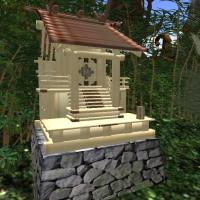To begin, Shintoism is not a religion, and yet it is. It’s the native belief system of Japan, and still in a sense very much alive and well, but it doesn’t identify itself as a body.
Shintoism focuses on this life. They aren’t concerned with teachings to earn your way into an afterlife. Their rites and prayers are a show of reverence for the “Kami”, the living spirits in the world, and in a sense they take a “civic” view of their relationship with the world and the Kami. The Kami are Gods in a sense. The most widely venerated being Amaterasu, the sun goddess, but they worship her not for the reasons most understood in the west. Not in deference to her “holiness”, but in recognition of her place.
Shintoism is not really a unified belief. It had a regional focus throughout Japan, and part of its practices is “filial piety” or prayer to the ancestors. Again, not as worship like we know it. Using the western view of worship in viewing Shintoism doesn’t really apply at all. In the Shinto view, you live in the world, and so do the spirit/gods. The purpose of prayer is not to show fealty. The fealty is a given. It’s more like a demonstration of unity, and a recognition of the unity of human governance with natural law.
It’s not unlike the old Druid view. So even a Japanese Christian will attend a Shinto function rather commonly, because they don’t really see them as religious functions, but more as community functions. When a child is born into a community with a Shinto shrine, a record of their name is made at the shrine, and they don’t seek permission. Not out of disrespect, but because their motivation isn’t “religious.” They believe the adding of the name is a recognition of that childs place. In the community they are called “family children.”
Greeting? Yes, basically greeting and acceptance. If by some oversight this name is not added, they believe that child on death will become a “water child.” A bringer of plague and misfortune, and it would not be that child’s fault but the communities.
How many have seen a Japanese torii arch? They’re common even in Japanese gardens in America. Often red, and just seem to be standing in a natural place, occasionally with a knot work banner across them. The banner looks like a large rope. Well, any Shinto shrine is seen as a nexus between the human world and the spirit world. A “gate”. So often, sort of like the western practice of wishing wells, they go to these gates to make prayers and a simple offering. Seeking the favour of the Kami, because the Kami are the spirits of all things in life, people, places, and things, and are seen as having influence. Now although they can be seen as roughly the equivalent of Gods, they were not seen as all knowing, all powerful, or omniscient. They have limitations despite their supernatural influence, and they can need help or to be reminded of stuff.
Are they limited to a local area? It depends on the specific Kami. All supernatural activity in the Shinto view is sort of a community effort, some ranging very far, others only in their area, or only influencing a select part of reality.
Though Shintoism has priests, they are not the “moral authority”. They instead function at the shrines sort of like a chamber of commerce. They are often seen as being more aware of the spirits, but not necessarily their “chosen”, or any more holy than anyone else. They just focus on the communal observances, weddings, funerals, things like that, births even.
In Shintoism, there are no “holy items” or profane ones, and spirits are not seen as having to dwell in any specific place. Spirit, the human form, is not seen as privileged. So often a Shinto shrine will have a mirror, and a household shrine may have the ancestral katana. This is seen as the dwelling place of the spirits, or one of their possible dwelling places, and to profane it is to invite disharmony into a community. It is seen as disrespect of the ancestors if it’s an ancestral relic.
Your thoughts are welcome. Be well friends.
Travis Saunders
Dragon Intuitive
~science,mysticism,spirituality~

